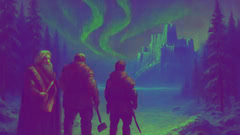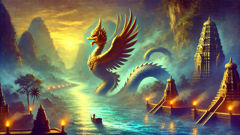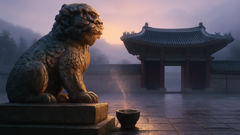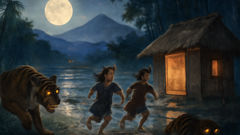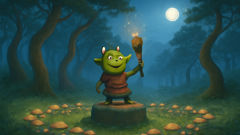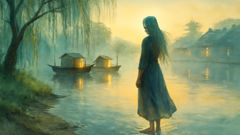Introduction
In the far north, where the earth crackles with the breath of ancient frost and the sky dances with emerald auroras, lies the land of Kalevala. This is a world half-forgotten, yet forever alive in the memory of its people—a tapestry woven with stories, legends, and the soft songs of the kantele drifting through pine and birch. In this age-old realm, magic breathes in every river and stone. Every glint of moonlight on snow might be the whisper of a forest spirit, every hush before dawn a hidden omen. The people of Kalevala are bound to the land as much as to their tales, living in harmony with the rhythms of nature but ever wary of the supernatural forces that lurk in shadow and mist. It is here, amid tangled woods and icy lakes, that the legend of the Sampo is born—a tale of hunger and hope, of heroes and sorceresses, and of the peril that waits at the edge of desire. The Sampo is no ordinary treasure. It is a mysterious artifact, forged by hands both mortal and divine, said to grind out endless grain, salt, and gold—prosperity itself—when turned. Whoever possesses the Sampo wields the power to transform the fate of entire peoples. Yet the Sampo does not rest in the hands of the virtuous. Instead, it lies guarded in the shadowy stronghold of Pohjola, a land of perpetual twilight ruled by Louhi, the Mistress of the North. Louhi is a figure of awe and dread, a witch whose cunning is matched only by her sorcery. Her kingdom is bleak, hemmed in by icy seas and haunted forests, where wolves prowl under perpetual dusk. She guards the Sampo fiercely, knowing that its power is both blessing and curse. Into this world step three heroes: Väinämöinen, the wise and ageless singer whose voice can calm storms and coax secrets from the earth; Ilmarinen, the peerless smith whose hands shape iron as easily as clay; and Lemminkäinen, the reckless adventurer whose charm is matched only by his bravado. Bound by a common quest—to bring fortune to their people and, perhaps, to themselves—they journey northward, risking all in pursuit of the Sampo. What follows is a story of rivalry and alliance, of magic both beautiful and dangerous, and of the choices that echo across generations. In the struggle for the Sampo, the heroes will confront not only Louhi but their own shadows, discovering that true prosperity is a prize hard won—and even harder kept.
The Forging of Destiny
The song of the kantele rose above the silent pines, notes shimmering like silver dew. Väinämöinen’s voice, deep and timeless, told of hunger and longing. In the village, winter’s grip was tight. Snow draped every roof, and families huddled around dim hearths, their bellies echoing with want. Crops had failed; salt was scarce; hope flickered low. But where mortals despaired, Väinämöinen’s resolve burned brighter. He called upon Ilmarinen, whose skill with metal was legend. Together, they planned to seek the Sampo, the mythical mill that could restore plenty to the land. The journey would not be easy. The Sampo, all agreed, belonged to Louhi, Mistress of the North—a sorceress as old as the forests, as wily as the arctic fox. She was said to weave winter storms as easily as she spun thread and to see every secret in the swirling snow. Yet need knows no boundary. As Väinämöinen gathered his companions—Ilmarinen and the impetuous Lemminkäinen—they felt the pull of fate, a sense that their actions would be sung for centuries.
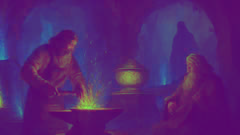
Their voyage northward was a trial by elements. The rivers froze beneath their sleds, and each night the wind howled like hungry wolves. Yet they pressed on, hearts steady and eyes fixed on distant Pohjola. Along the way, Väinämöinen played his kantele and sang spells against the biting cold. Ilmarinen repaired their sled runners with iron filigree, while Lemminkäinen’s laughter echoed through the trees, daring the lurking spirits to try their luck. One evening, as they camped on the edge of the tundra, an owl—a messenger of omens—alighted near their fire. Its eyes glimmered with unspoken warning. Lemminkäinen, ever brash, wanted to chase it away, but Väinämöinen hushed him. “Every sign has meaning,” he murmured. “Tonight, we stand at the crossroads of fate.”
When they reached the borders of Pohjola, the world seemed to shift. The air grew colder, heavy with enchantment. Trees twisted in unnatural ways, and will-o’-the-wisps flickered over icy bogs. In this land of shadows, Louhi awaited. The old witch received the heroes with measured courtesy, her eyes sharp as knives. She proposed a challenge: if Ilmarinen could forge a Sampo finer than any before, she would gift it to them. The task demanded not only skill but also courage, for Louhi set Ilmarinen to work in a forge deep within her keep—where iron sang and embers glowed blue with magic. Days turned to nights as Ilmarinen toiled, hammering and shaping, sweating despite the endless cold. Väinämöinen kept watch, his songs weaving protections around his friend. Lemminkäinen, restless, scouted the dark woods for threats both natural and spectral. At last, the Sampo emerged: a marvel of artifice—its lid etched with stars, its base rooted in earth and sky, its turning promised bounty for generations.
But Louhi, ever cunning, kept her promise in spirit but not in heart. She locked the Sampo away in a vault of stone and ice, deep beneath Pohjola. The heroes’ hearts ached with frustration. They had fulfilled their part, yet the treasure eluded them. Still, hope was not lost. Väinämöinen, wise in the ways of both word and magic, counseled patience. “All things that are hidden may yet be found,” he said. The heroes began to plot, knowing that the greatest challenge was yet to come: to win the Sampo not by bargain, but by daring.
The Theft and the Storm
The plan to reclaim the Sampo demanded guile, unity, and not a little luck. Louhi’s lair was a fortress—walls thick with ancient runes, guards more beast than man, and a darkness that pressed on the soul. Each hero played his part. Väinämöinen lulled the sentries to sleep with a melody spun from sorrow and longing. Ilmarinen bent iron into silent keys and cunning levers, tools for locks that had never before been breached. Lemminkäinen darted through the shadows, swift as a fox, sowing confusion among the lesser spirits who served Louhi.
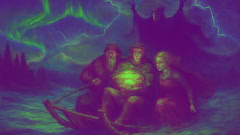
They moved through echoing corridors, hearts pounding. Ice crystals flashed in their torchlight like a thousand watching eyes. When they reached the vault, Ilmarinen’s hands worked swiftly. The doors shuddered open, revealing the Sampo at last—a marvel resting on its pedestal, humming softly with promise. Its lid was embossed with the constellations; its base rooted into a swirling mandala that seemed to spin even as it stood still. As Ilmarinen freed it from its moorings, a deep tremor shook Pohjola. Outside, the sky boiled with unnatural clouds. Louhi sensed her loss. Her rage awakened the very land. Thunder rolled; winds lashed the keep; wolves howled in wild chorus. The heroes fled, Sampo in hand, pursued by Louhi and her monstrous servants. Their sled careened down icy slopes, spray of snow rising in their wake. Väinämöinen chanted spells for speed and shelter. Ilmarinen steered with grim focus. Lemminkäinen fought off shadowy beasts that snapped at their heels.
As they neared the borderlands, Louhi unleashed her greatest sorcery. The sky darkened until it was black as pitch, then cracked open with blinding lightning. A cyclone whirled down from the clouds, roaring with Louhi’s fury. In the chaos, the sled splintered. The Sampo slipped from their grasp, tumbling toward the churning sea. In desperation, Väinämöinen and Ilmarinen grabbed at it—hands clutching iron and gold—but Louhi swooped in, her cloak billowing like storm clouds. She and the heroes fought on the shoreline, waves battering stone and sand. At the height of the struggle, the Sampo shattered. Its pieces scattered into the waters and along the coasts of Kalevala. The world stilled. Louhi vanished, wounded and bitter. The heroes collapsed, exhausted and heartsick.
Yet something strange happened in the days that followed. Along every beach where a shard of the Sampo washed ashore, wildflowers bloomed out of season. Salt crystallized in river mouths; wheat sprouted in rocky ground. The land, once barren, grew bountiful again—not in endless measure, but enough. Väinämöinen, Ilmarinen, and Lemminkäinen understood then: though they had lost the Sampo, its spirit remained, scattered through the world like seeds of hope. The people of Kalevala would thrive, not through magic alone, but by courage, unity, and the wisdom learned through hardship.
Legacy of the Sampo
In the years after the Sampo’s breaking, life in Kalevala changed subtly but profoundly. The people found unexpected blessings in ordinary places—berries ripening in forgotten glens, veins of silver glinting beneath old stones, sudden surges of fish in long-empty streams. No one could say for certain if these miracles were fragments of the Sampo’s power or simply the fruits of renewed hope and toil. The elders taught their children that prosperity was not something to be seized by force or guarded with jealousy, but a gift to be shared and nurtured.
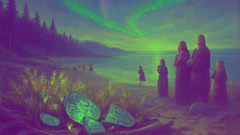
Väinämöinen grew older, his songs deepening with sorrow and wisdom. He saw that every gain carried its own cost, that the land’s plenty must be protected by respect and gratitude. Ilmarinen continued to craft wonders—plows that turned the hardest soil, lanterns that glowed long into winter nights—but he learned to temper ambition with care for his neighbors. Lemminkäinen, changed by his brush with loss and magic, became a quieter man—his laughter softer, his courage deeper. The heroes were celebrated for generations, not for possessing the Sampo, but for daring to seek it and for what their quest revealed about the heart of their people.
Louhi retreated to her northern fastness, her power dimmed but not destroyed. From time to time, travelers glimpsed her silhouette on stormy horizons—a reminder that magic endures in wild places and that every blessing has its shadow. The tale of the Sampo was woven into lullabies and festival songs, its lessons echoing through centuries: That unity is stronger than any magic; that greed can shatter even miracles; and that true prosperity lies not in treasure, but in resilience, hope, and the bonds that tie community together. Thus does the legend of the Sampo endure, forever spun anew by each telling, as enduring as the northern lights over Kalevala.
Conclusion
The story of the Sampo is a reminder that even in the harshest winters—be they of weather or of spirit—the seeds of renewal are waiting beneath the snow. Its fragments, scattered across land and sea, speak to the enduring truth that prosperity cannot be hoarded by one hand alone. It grows strongest when shared, when won through wisdom, courage, and unity. The heroes of Kalevala did not return with a miracle intact, but their journey transformed their world all the same. In every field that flourished anew, in every hearth that glowed brighter for their courage, the true magic of the Sampo endured. So too does its story—told beside fires on winter nights or sung as a lullaby under northern lights—a tale that asks us to find hope in hardship, to cherish what binds us together, and to believe that even lost wonders can leave a legacy for all.

